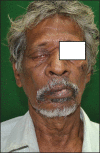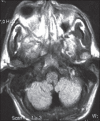Facial nerve paralysis: A case report of rare complication in uncontrolled diabetic patient with mucormycosis
- PMID: 25810669
- PMCID: PMC4367044
- DOI: 10.4103/0976-9668.149195
Facial nerve paralysis: A case report of rare complication in uncontrolled diabetic patient with mucormycosis
Abstract
Mucormycosis is a rare opportunistic aggressive and fatal infection caused by mucor fungus. Seven types of mucormycosis are identified based on the extension and involvement of the lesion, of which the rhino orbital mucormycosis is most common in the head and neck region. Although it is widely spread in nature, clinical cases are rare and observed only in immunocompromised patients and patients with uncontrolled diabetes mellitus. Early symptoms include fever, nasal ulceration or necrosis, periorbital edema or facial swelling, paresthesia and reduced vision. Involvement of cranial nerves although not common, facial nerve palsy is a rare finding. The infection may spread through cribriform plate to the brain resulting in extensive cerebellar infarctions. Timely diagnosis and early recognition of the signs and symptoms, correction of underlying medical disorders, and aggressive medical and surgical intervention are necessary for successful therapeutic outcome.
Keywords: Diabetes mellitus; facial nerve palsy; mucormycosis.
Conflict of interest statement
Figures




Similar articles
-
Facial Nerve Palsy as Complication in COVID-19 Associated Mucormycosis: A Case Series.Cureus. 2022 Dec 29;14(12):e33077. doi: 10.7759/cureus.33077. eCollection 2022 Dec. Cureus. 2022. PMID: 36726898 Free PMC article.
-
Facial Nerve Palsy in COVID-19-Associated Mucormycosis Patients: A Case Series.Cureus. 2021 Nov 2;13(11):e19208. doi: 10.7759/cureus.19208. eCollection 2021 Nov. Cureus. 2021. PMID: 34873538 Free PMC article.
-
Chronical rhino-orbital mucormycosis in an immunocompetent host: A case report.Int J Surg Case Rep. 2021 May;82:105882. doi: 10.1016/j.ijscr.2021.105882. Epub 2021 Apr 10. Int J Surg Case Rep. 2021. PMID: 33865198 Free PMC article.
-
COVID-19-associated rhino-orbital-cerebral mucormycosis: A systematic review, meta-analysis, and meta-regression analysis.Indian J Pharmacol. 2021 Nov-Dec;53(6):499-510. doi: 10.4103/ijp.ijp_839_21. Indian J Pharmacol. 2021. PMID: 34975140 Free PMC article.
-
Managing mucormycosis in diabetic patients: A case report with critical review of the literature.Oral Dis. 2022 Apr;28(3):568-576. doi: 10.1111/odi.13802. Epub 2021 Mar 2. Oral Dis. 2022. PMID: 33583133 Review.
Cited by
-
Rhino-orbital-cerebral mucormycosis with Klebsiella and MRSA co-infection in a diabetic patient: a case report.Ann Med Surg (Lond). 2024 Aug 2;86(9):5590-5594. doi: 10.1097/MS9.0000000000002416. eCollection 2024 Sep. Ann Med Surg (Lond). 2024. PMID: 39239010 Free PMC article.
-
Rhino-orbito-cerebral mucormycosis in patients with uncontrolled diabetes: A case series.Int J Surg Case Rep. 2020;73:324-327. doi: 10.1016/j.ijscr.2020.07.011. Epub 2020 Jul 15. Int J Surg Case Rep. 2020. PMID: 32738774 Free PMC article.
-
Facial Nerve Palsy: An Unusual Presentation in Patients with Rhino Cerebral Mucormycosis.Indian J Otolaryngol Head Neck Surg. 2019 Nov;71(Suppl 3):2110-2113. doi: 10.1007/s12070-018-1530-1. Epub 2018 Nov 20. Indian J Otolaryngol Head Neck Surg. 2019. PMID: 31763303 Free PMC article.
-
Rhino-Orbito-Cerebral Mucormycosis During the Second Wave of Covid-19: The Indian Scenario.Indian J Otolaryngol Head Neck Surg. 2022 Oct;74(Suppl 2):3492-3497. doi: 10.1007/s12070-021-02978-y. Epub 2021 Nov 12. Indian J Otolaryngol Head Neck Surg. 2022. PMID: 34786356 Free PMC article.
-
Facial Nerve Palsy as Complication in COVID-19 Associated Mucormycosis: A Case Series.Cureus. 2022 Dec 29;14(12):e33077. doi: 10.7759/cureus.33077. eCollection 2022 Dec. Cureus. 2022. PMID: 36726898 Free PMC article.
References
-
- Santos Gorjón P, Blanco Pérez P, Batuecas Caletrío A, Muñoz Herrera AM, Sánchez González F, de la Fuente Cañibano R. Rhino-orbito-cerebral mucormycosis, a retrospective study of 7 cases. Acta Otorrinolaringol Esp. 2010;61:48–53. - PubMed
-
- Koc Z, Koc F, Yerdelen D, Ozdogu H. Rhino-orbital-cerebral mucormycosis with different cerebral involvements: Infarct, hemorrhage, and ophthalmoplegia. Int J Neurosci. 2007;117:1677–90. - PubMed
-
- Cohen SG, Greenberg MS. Rhinomaxillary mucormycosis in a kidney transplant patient. Oral Surg Oral Med Oral Pathol. 1980;50:33–8. - PubMed
-
- Davis RL, Robertson DM. 2nd ed. Baltimore: Williams & Wilkins; 1991. Textbook of Neuropathology; pp. 761–3.
Publication types
LinkOut - more resources
Full Text Sources
Other Literature Sources
